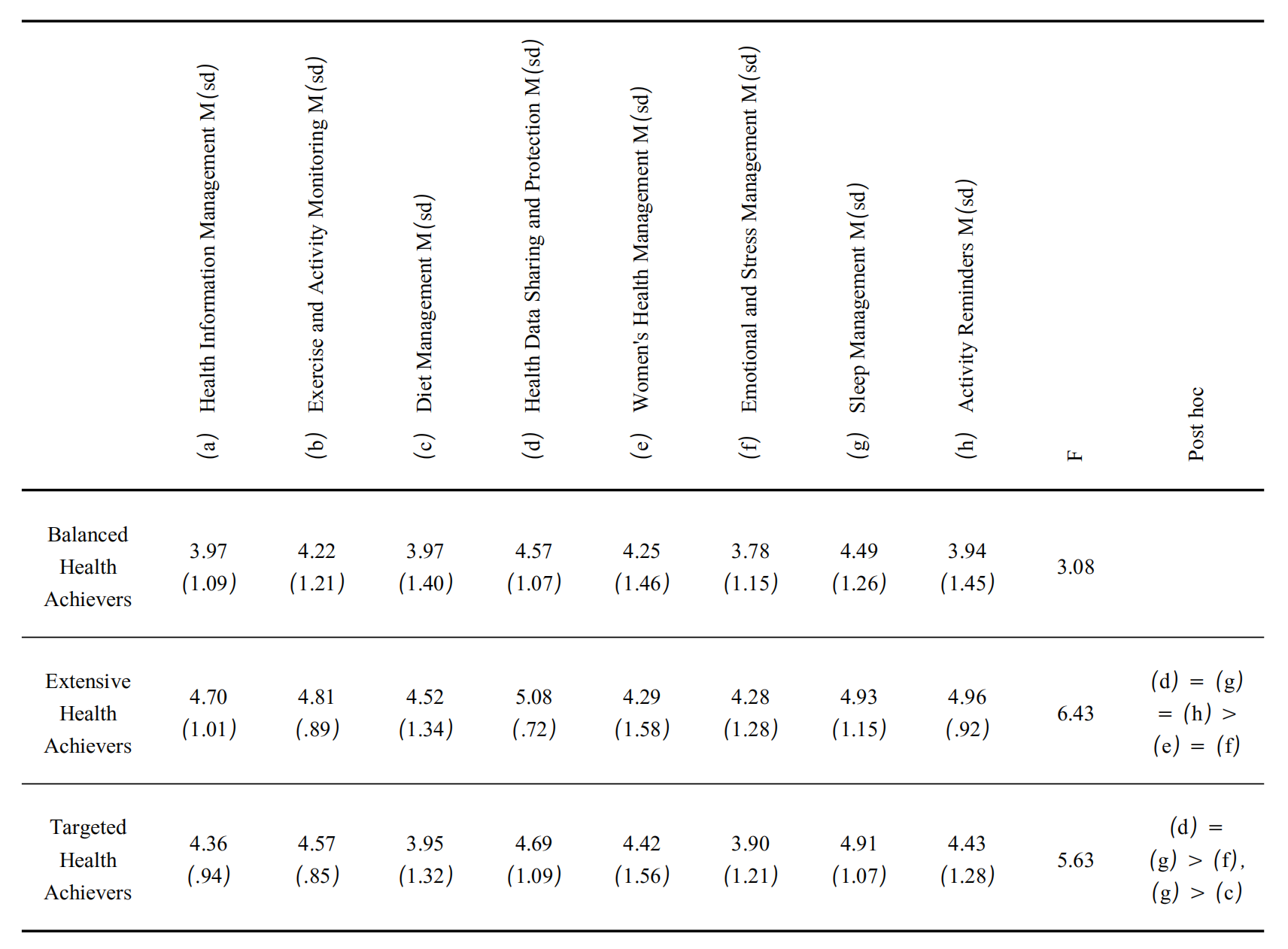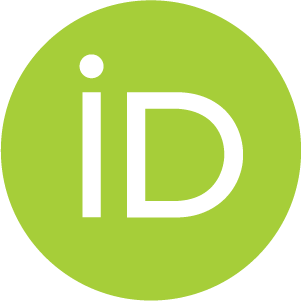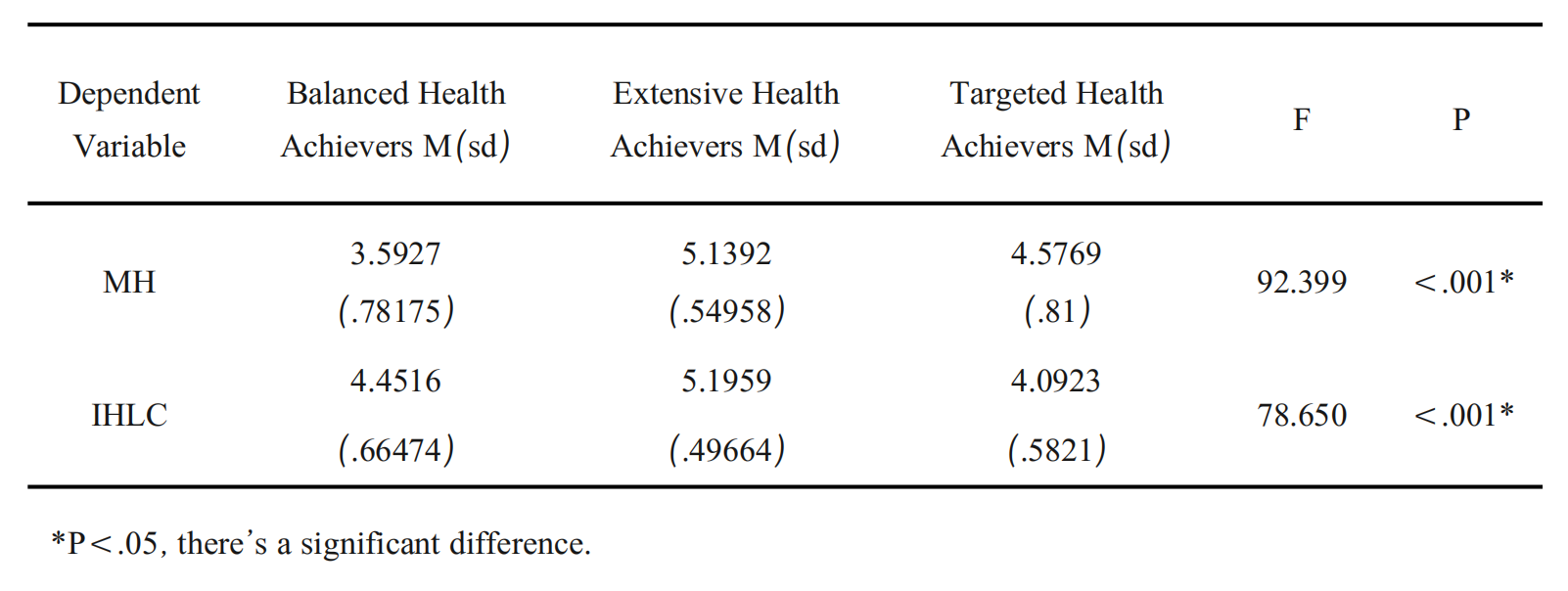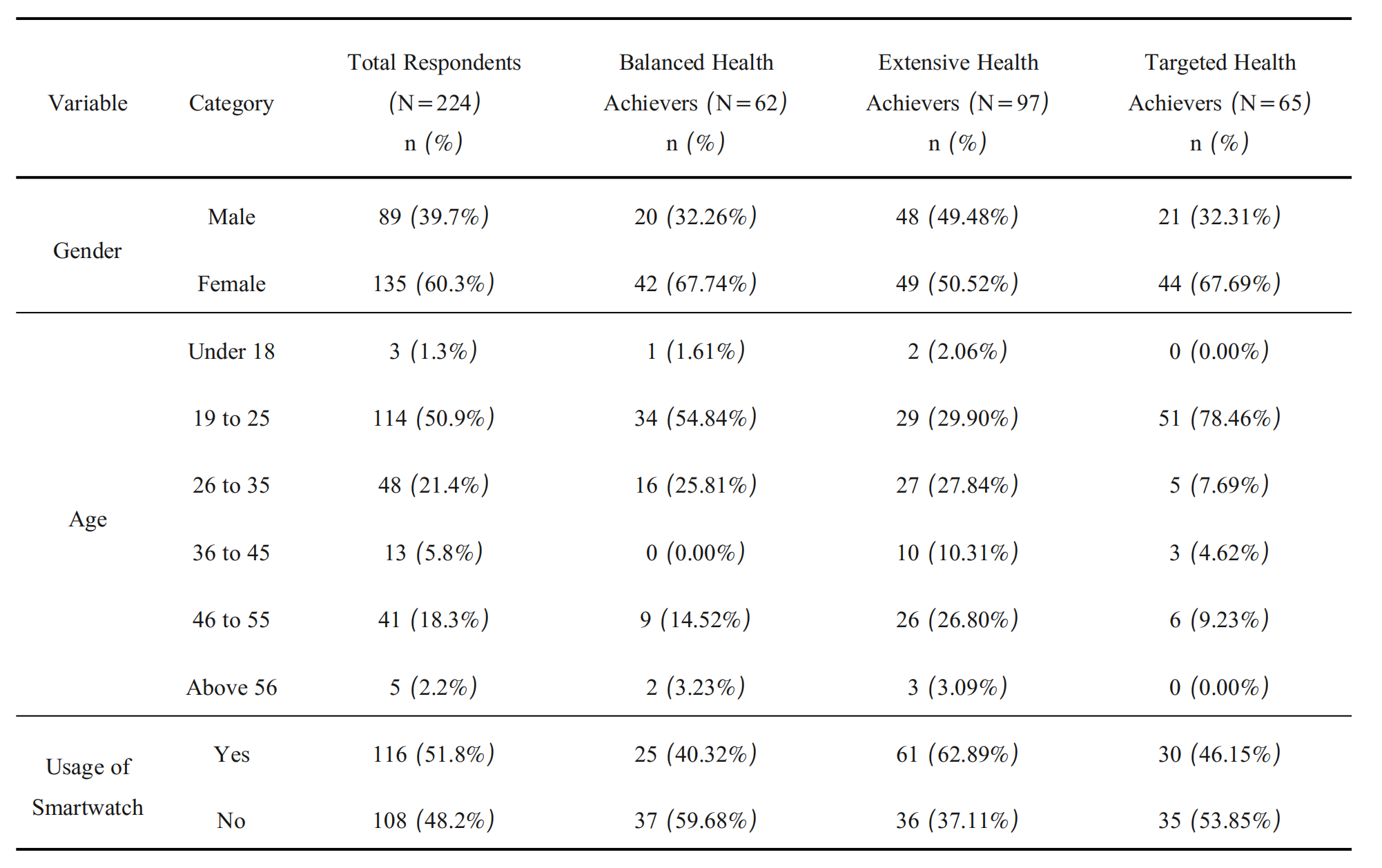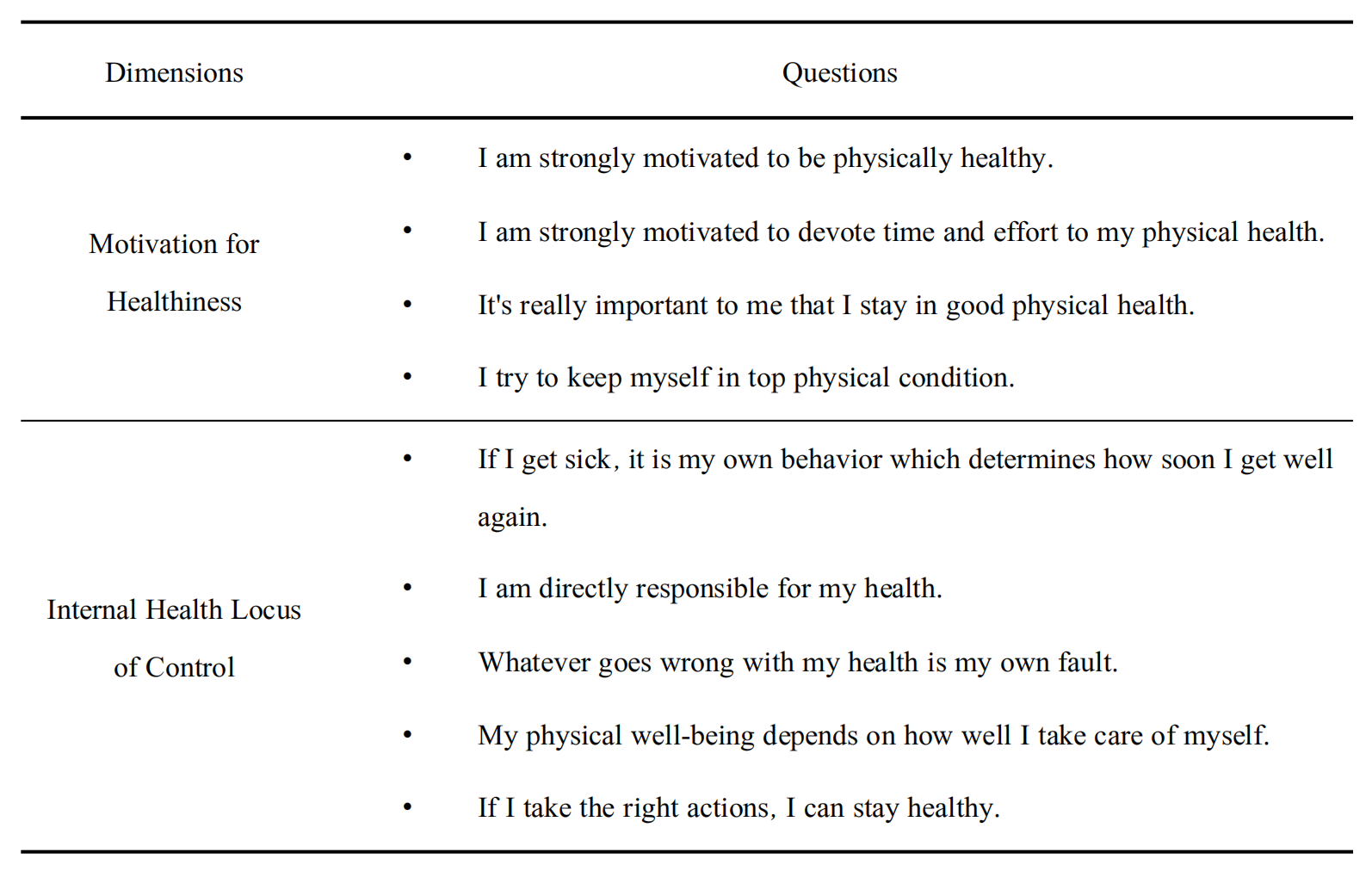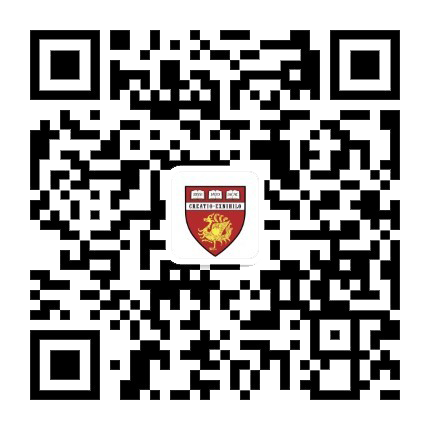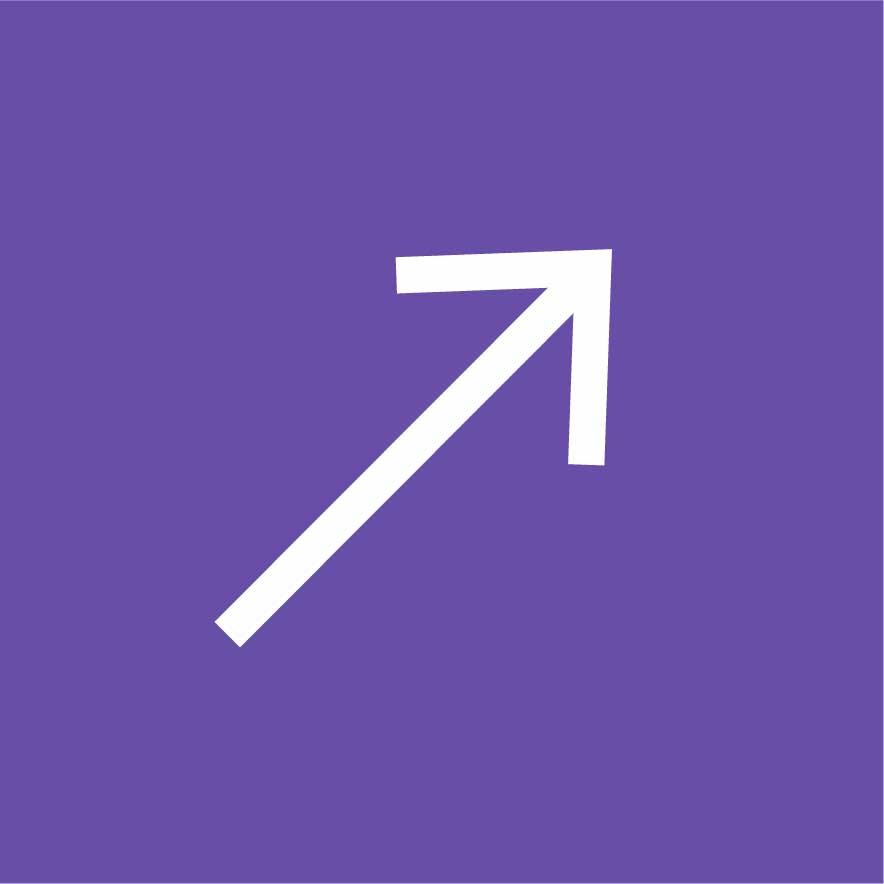In summary, while all three clusters have similar needs for women's health and sleep management, Extensive Health Achievers demonstrate a notably higher demand for health information management, exercise monitoring, and emotional support, as well as for diet management, health data sharing, and activity reminders. These differences suggest varied priorities and focuses among the clusters, influencing how they engage with health services and technologies.
Conclusion
This study investigated the distinctions among users based on MH and IHLC, classified their mHealth service requirements, and analyzed the commonalities and differences in demand across different clusters.
First, user characteristics such as Motivation for Healthiness (MH) and Internal Health Locus of Control (IHLC) can be used as effective variables for segmenting mHealth service users. We examined how MH and IHLC characteristics influence users’ needs for mHealth services. MH refers to an individual's enthusiasm for pursuing health goals, while IHLC reflects their sense of control over their own health status. These characteristics are crucial for understanding user needs as they can reveal how users perceive health management and the role of digital health tools. Our analysis showed significant differences in MH and IHLC among user groups. For instance, Extensive Health Achievers scored highest in both MH and IHLC, indicating a strong interest and confidence in health management. These users are likely to prefer health service systems that offer personalized recommendations and self-control features. In contrast, Balanced Health Achievers, while having a certain level of belief in health control, showed lower MH, suggesting that their needs might focus more on basic features of health service systems. These differences in user characteristics should be considered in the design of health service systems. Future research could further explore how to tailor health service systems based on these characteristics to enhance their appeal and effectiveness for different user groups.
Second, health data sharing and protection, and sleep management can be considered fundamental features for mHealth products, while companies should explore remaining categories to develop personalized health products. We classified 40 mHealth services into eight categories using exploratory factor analysis. The eight categories are health information management, exercise and activity monitoring, diet management, health data sharing and protection, women's health management, emotional and stress management, sleep management, and activity reminders. Among all users, health data sharing and protection emerged as the most prioritized features. As digitization of health data becomes a global trend, increased efforts should be made to encourage both medical clinics and the public to utilize these features for more effective health management. Current products, such as fall detection systems, can activate protocols to assist users swiftly when a fall is detected. Future developments could expand these protection features, such as incorporating smartwatches that monitor abnormal heart rates. If these rates exceed a set threshold, the smartwatch could alert the user and automatically notify emergency contacts with real-time location and health data, ensuring prompt medical assistance. Such features help identify potential health crises early and provide rapid responses in emergencies, enhancing first aid efficiency and survival rates. On the other hand, sleep management is also of significant importance to users. Many studies have focused on sleep-related features in mobile devices [24, 25]. Future research should further explore users' sleep issues, such as insomnia and poor sleep quality, and develop new features to address these problems and better meet users' needs. These two categories—health data sharing and protection, and sleep management—emerge as high-demand functions across all three clusters and can be considered fundamental features for mHealth products. Companies should prioritize these services when developing new mHealth solutions. Additionally, further research into the remaining categories is essential to uncover specific needs associated with various health behaviors of users. By gaining deeper insights into these categories, companies can better tailor their products to meet diverse user requirements and enhance the overall effectiveness of mHealth solutions.
MHealth Service Requirements Across User Segments
This study aims to understand the differences and similarities in the needs of various users for health service systems based on their characteristics. Previous sections have identified eight mHealth service categories and three distinct health attitude clusters. Figure 3 provides a visual comparison of the overall data and the three clusters. Next, this study will detail the differences in service expectations within each cluster across the categories, as well as differences across clusters within each category, to gain deeper insights.
This study will now analyze the results from the perspective of each cluster across the categories (Table 6). For Balanced Health Achievers, there are no significant differences in the importance of requirements across the eight categories, and their average scores for each category are low compared to the overall average. This suggests that this group does not have a particularly high demand for any specific service among these categories. In contrast, Extensive Health Achievers show a markedly higher demand for health data sharing and protection, sleep management, and activity reminders, compared to women's health management and emotional and stress management. This indicates that they place a higher priority on services related to health data sharing and management, maintaining healthy sleep patterns, and receiving reminders for physical activities, while their interest in women's health and emotional well-being is comparatively lower. For Targeted Health Achievers, there is a notable disparity in their demands. Health data sharing and protection, as well as sleep management, are significantly more important to them than emotional and stress management. Additionally, their need for sleep management is much higher than their demand for diet management. This underscores their strong focus on sharing and managing health data and ensuring good quality sleep, with less emphasis on stress and dietary management.
Share and Cite
Chicago/Turabian Style
Hsuan-Chi Wen and Fang-Wu Tung, "Exploring User Requirements for Mobile Health Service Systems." JDSSI 2, no.3 (2024): 34-52.
AMA Style
Hsuan-Chi Wen and Fang-Wu Tung. Exploring User Requirements for Mobile Health Service Systems. JDSSI. 2024; 2(3): 34-52.
© 2024 by the authors. Published by Michelangelo-scholar Publishing Ltd.
This article is published under the Creative Commons Attribution-NonCommercial-NoDerivs 4.0 International (CC BY-NC-ND, version 4.0) license (https://creativecommons.org/licenses/by-nc-nd/4.0/), which permits non-commercial use, distribution, and reproduction in any medium, provided the original work is properly cited and not modified in any way.
Balanced Health Achievers
This group constitutes 27.7% (62 participants) of the total, comprising 20 males (32.26%) and 42 females (67.74%). Although the age distribution in this group is consistent with the overall percentages, their usage of smartwatches is significantly lower than the overall rate, at only 40.32%. This group takes a balanced approach to health management. They have a moderate level of health motivation and a relatively strong belief in their ability to influence their health outcomes. While not extreme in their efforts, they are consistent in working toward maintaining a healthy lifestyle, achieving a reasonable level of success in their health goals. Their balanced engagement across various health aspects reflects a sustainable, steady pursuit of well-being.
Extensive Health Achievers
This group is the largest, comprising 43.3% (97 participants) of the total, with 48 males (49.48%) and 49 females (50.52%). Compared to the overall respondents, this group has a notably higher proportion of males. The age distribution within this group is distinct from that of the overall respondents: participants aged 19 to 25 account for only 29.9%, while those aged 26 to 35 make up 27.84%. Notably, individuals aged 46 to 55 constitute 26.80%, making this group’s age composition the most balanced among the three clusters. Furthermore, the percentage of smartwatch usage in this group is notably higher than the overall rate, at 62.89%. The Extensive Health Achievers are highly motivated individuals who actively focus on nearly all aspects of their health. With a strong drive to improve their overall well-being, they are involved in a wide range of health-related behaviors. Although they may not cover every single health aspect, their efforts are broad and extensive. Their belief in their ability to influence their health outcomes supports their proactive approach, leading to significant achievement across multiple areas of health.
Targeted Health Achievers
This group comprises 29% (65 participants), with 21 males (32.31%) and 44 females (67.69%). The majority of this group is composed of individuals aged 19 to 25 years (78.46%), making it the group with the highest proportion of young people among the three clusters. Within this group, 46.15% have used smartwatches, which is lower compared to the overall percentage of respondents with smartwatch experience. The Targeted Health Achievers are highly motivated individuals with a strong focus on specific health aspects rather than a broad, all-encompassing approach. Their high health motivation drives them to engage deeply in particular areas of health, while their slightly above-average belief in their ability to control health outcomes reflects a confidence in managing those targeted aspects. This group takes a purposeful and focused approach, concentrating on health behaviors that are most relevant to their personal goals, without striving to cover every dimension of health.
Table of Contents
- Abstract
- Introduction
- Literature Review
- Methodology
- Results & Analysis
- Conclusion
- Limitation and Recommendations for Future Work
- Acknowledgements
- Conflicts of Interest
- References
Clustering and Understanding the MHealth Ecosystem
Statista reports a notable surge in the number of mHealth applications, indicating an increase with over 65,300 available on Google Play [12] and 54,000 on the Apple App Store [13]. These applications provide a diverse array of services, including fitness monitoring, medication reminders, telemedicine services, women's health monitoring, and mental well-being support. The sheer abundance of mHealth applications can feel overwhelming, highlighting the critical need for categorization to facilitate better organization and comprehension of the vast mHealth landscape.
By grouping mHealth applications according to their functions, target audience, and health focus areas, users can efficiently navigate the extensive array of options available [14]. This approach aids in making well-informed decisions when selecting applications that align with individual health and wellness goals. Wu et al. (2019) emphasized the importance of taxonomy in defining and comparing application features, particularly in the context of diabetes-related applications [15]. Furthermore, Peng et al. (2020) conducted a bibliometric analysis that identified clusters related to technology development, mental health, telemedicine, chronic disease management, health behavior, and disease prevention [16]. This comprehensive examination highlighted the benefits of clustering in understanding the interconnected nature of health services and user perspectives.
Providing a comprehensive taxonomy of mHealth services is instrumental in helping users grasp the landscape of mHealth applications and their functionalities. User insights on mHealth services can further enrich the taxonomy by showcasing how users perceive different functions. Initially categorizing mHealth services from the multitude of applications and creating taxonomies based on user evaluations allows for comparison and assessment of these services, ultimately culminating in a taxonomy of mHealth services that resonates with users. This process unveils relationships and synergies among services, offering perspectives on the health applications ecosystem. Therefore, beyond functions, target users, and health focus areas, user perceptions play a pivotal role in clustering, highlighting the widespread impact of mHealth applications.
Literature Review
MHealth Service Systems
MHealth service systems refer to the provision of health-related services through mobile devices, enabling continuous health monitoring, prompt diagnosis, and immediate interventions in a mobile environment [6]. The integration of mobile devices with mHealth applications has given rise to intelligent product-service systems, facilitating real-time monitoring of essential health parameters. These smart PSSs empower users to make well-informed decisions concerning their lifestyle choices and health management [7]. MHealth services have emerged as an innovative approach in healthcare delivery, leveraging mobile devices to improve access to information, monitoring tools, and interventions that promote well-being [8]. Within the realm of wearable devices like smart rings and watches, there is a noticeable trend towards enhancing health monitoring capabilities.
The scope of mHealth services is expanding with the introduction of new mobile technologies, encompassing a broader concept that includes a diverse range of health services [8, 9, 10]. These services are tailored to address various health dimensions such as nutrition, physical activity, sleep, and mental well-being through digital interventions aimed at catalyzing behavioral changes and supporting overall health [11]. Furthermore, the incorporation of artificial intelligence (AI) algorithms in mHealth applications has transformed personalized health recommendations and predictive analytics. The continuous advancement of ICT has led to significant strides in the field of mHealth, enabling individuals to monitor and proactively manage their health and fitness. The development of mHealth services also aligns with the goals of public health by offering convenient access to health services irrespective of geographical location or time constraints, thereby promoting equitable access to healthcare resources and enhancing health outcomes for all individuals.
Abstract: This study investigates the evolving role of mHealth services, emphasizing their potential to enhance well-being and promote a healthy lifestyle. The widespread adoption of mobile devices has led to a surge in mHealth services and a growing user base, creating the challenge of developing services that meet diverse needs. This research explores the requirements of different user segments for mHealth services, using health motivation and control beliefs as the basis for segmentation. The study categorizes mHealth services into eight distinct categories based on user perceptions and assesses how different segments prioritize and value these services. The findings offer insights into the characteristics and preferences of various mHealth user segments, guiding the development of targeted mHealth services that enhance engagement and overall well-being. Ultimately, this study contributes to innovation and development within the mHealth industry, providing a pathway for creating more effective and comprehensive service systems that address the varied needs of the population, fostering a more personalized approach to healthcare delivery.
Hsuan-Chi Wen 1, Fang-Wu Tung 2 *
by
1 Department of Design, National Taiwan University of Science and Technology, Taiwan
2 Department of Arts and Design, National Tsing Hua University, Taiwan
* Author to whom correspondence should be addressed.
JDSSI. 2024, 2(3), 34-52; https://doi.org/10.59528/ms.jdssi2024.1009a21
Received: September 26, 2024 | Accepted: October 5, 2024 | Published: October 9, 2024
Segmenting MHealth Users by Health Factors
User acceptance of mHealth applications is influenced by various factors such as perceived utility, attitudes towards behavior, subjective norms, and facilitating conditions [17]. In order to comprehend the adoption of these applications by individuals, it is crucial to consider users' health attitudes. Research should encompass elements of health consciousness, indicating the level of dedication individuals have towards maintaining their health [18]. Through the segmentation of mHealth users based on their health attitudes, developers can attain a more distinct understanding of their target audience. This comprehension enables them to customize services more efficiently, catering to the specific requirements and preferences of different user segments.
Concerning health attitudes, two significant concepts to consider are Motivation for Health and Internal Health Locus of Control [19]. Motivation for Health (MH) denotes an individual's inclination to participate in health-related endeavors such as physical exercise or adopting healthy lifestyle choices. By gauging users' levels of health motivation, developers of mHealth applications can create features that align with users' inherent motivations, consequently enhancing engagement and adherence to healthy practices. Internal Health Locus of Control (IHLC) is a component of the Health Locus of Control (HLC) framework, focusing on individuals' belief in their capacity to impact their health outcomes through their actions [20]. Individuals with a robust IHLC are more inclined to actively engage in managing their health and utilizing mHealth tools to oversee and enhance their well-being. By taking IHLC into account in user segmentation, mHealth applications can be designed to assist users in embracing and sustaining healthy habits.
The segmentation of mHealth users based on Motivation for Health (MH) and Internal Health Locus of Control (IHLC) offers a promising perspective on users. This approach facilitates the creation of more personalized and efficient services, guaranteeing that mHealth applications effectively cater to the diverse requirements of their users.
Author Contributions
Hsuan-Chi Wen was responsible for data collection and conducted the statistical analysis. She also participated in the interpretation of the results and contributed to writing the Methodology, Results & Analysis, and Conclusion sections of the paper.
Fang-Wu Tung conceptualized the research topic and supervised the experimental execution, data analysis, and discussion. She also authored the introduction and literature review sections.
Funding
The project was supported by the National Science and Technology Council of Taiwan under grant NSTC 112-2410-H-007-101 & 113-2410-H-007-014-MY2.
Acknowledgements
The authors would like to express their gratitude to the reviewers for their valuable feedback, and to all the participants who took the time to complete the questionnaires.
Conflicts of Interest
The authors declare that they have no conflicts of interest related to this research.
With the proliferation of mHealth applications, there is a broad potential for health services ranging from monitoring user fitness to aiding mental health or managing chronic conditions. However, due to the increasing number of mHealth applications, users may struggle to evaluate the array of services available. The categorization of these app services based on user needs would facilitate decision-making and improve comprehension of how users perceive the connections among these services. Understanding users' attitudes towards their requirements from mHealth services illuminates the classification process, ensuring that services are tailored to address user needs effectively.
Examining how different user segments prioritize and value diverse mHealth services yields in-depth insights into the needs and preferences of specific sub-populations. These insights guide the development of targeted mHealth services that enhance user engagement and overall well-being. This study contributes to mHealth services research with primary objectives: first, segmenting mHealth app users based on their health attitudes into distinct groups with shared health beliefs and attitudes; and second, classifying the diverse services offered by mHealth applications based on user evaluations. Additionally, this research investigates the specific requirements of different user segments for mHealth services, providing a deeper understanding of each segment's needs. This understanding can drive the development of mHealth services, potentially leading to broader service ecosystems within the mHealth industry. The findings of this research will contribute to innovation in the mHealth industry, facilitating the creation of mHealth service systems tailored to meet the diverse needs of the population, ultimately advancing public wellness.
(E) Women's Health Management
This category focuses on women's health, with mHealth services tailored to record unique health data, track menstrual patterns, and provide cycle reminders. These applications not only monitor menstruation but also address other symptoms requiring attention. By helping women understand their body conditions, these applications aid in preventing potential health issues. Key features often include symptom trackers for PMS (pre-menstrual syndrome), ovulation calculators for those trying to conceive, and educational resources about women's health. Some applications offer personalized insights based on historical data, such as predicting optimal fertility periods or identifying hormonal patterns. By offering comprehensive tools and support, these applications empower women to actively manage their health and address emerging concerns effectively.
(F) Emotional and Stress Management
This category addresses mental health issues through mHealth services designed to monitor mood and support mental health management. These applications provide incentives to encourage engagement in health management, helping users manage and alleviate stress. Techniques may include shifting perspectives or engaging in stress-relief activities. These applications aim to prevent serious mental health issues and promote ongoing well-being. Features often include guided meditation, cognitive behavioral therapy (CBT) exercises, and mood tracking charts. Guided meditation assists with mindfulness and relaxation, CBT exercises help address negative thought patterns, and mood tracking charts identify patterns and triggers. By integrating these tools, mental health mHealth applications offer comprehensive support for proactive mental health management and maintaining emotional balance.
(G) Sleep Management
This category includes sleep-focused mHealth services that provide detailed sleep assessments and personalized health recommendations. These applications monitor users' sleep patterns and offer feedback the following morning. They also analyze sleep data over various periods—one week, one month, and six months—to deliver tailored advice. By using these applications, users can gain insights into their sleep habits, make adjustments to enhance sleep quality, and improve overall health through better rest. Key features often include sleep cycle tracking, which helps users understand sleep stages and identify factors affecting sleep quality. Some applications offer personalized sleep goals and strategies for improving sleep hygiene, such as optimizing room temperature or light exposure. By addressing both sleep quality and quantity, these applications support users in achieving restorative rest and enhancing overall well-being.
(H) Activity Reminders
This category focuses on mHealth services designed to remind users to move and take breaks. These applications address the sedentary nature of modern lifestyles by providing timely prompts to engage in physical activity, stretch, or take short breaks. Features typically include customizable reminder settings to fit individual needs and schedules, as well as integrated exercise routines or stretch guides. Some applications also track and analyze sedentary behavior, offering insights into activity patterns and progress. By encouraging more movement throughout the day, these applications help reduce the risk of health issues related to prolonged inactivity, such as cardiovascular disease and musculoskeletal problems, and promote overall well-being.
Questionnaire Design and Distribution
The purpose of this study is to understand the needs of different segments regarding health services for mobile devices. To comprehensively understand existing digital health services, this study collects information on mHealth service systems from current products and industry reports. According to the industry report by Innovation Eye, Big Innovation Centre, and Deep Knowledge Analytics [21], the mHealth industry encompasses a wide range of sectors, including Diet and Fitness, Diet and Nutrition, Femtech, SleepTech, Mental Health, Personal Health, and TeleHealth. Based on existing product features and projections for future development, this study initially clustered into 40 mHealth services.
To better understand the needs of different demographic groups for smartwatch health service systems, this study utilizes MH and IHLC dimensions from health orientation scales [22, 23] as the basis for segmentation (Table 1). The study aims to explore the demands of various health attitude groups towards mHealth service systems, identifying differences and similarities among these groups to provide companies with insights for customer and product segmentation.
Exploring User Requirements for Mobile Health Service Systems
Introduction
There is a notable transformation in healthcare delivery, marked by the emergence of mobile health (mHealth) applications as powerful tools for promoting well-being and a healthy lifestyle. This shift is driven by the widespread use of mobile devices in conjunction with an increasing emphasis on health and quality of life. As a result, a variety of mHealth applications have surfaced in the market, offering different services tailored to health management and lifestyle maintenance. Research findings by Shiyab (2024) highlight the significant benefits of mHealth in supporting public health initiatives, enhancing self-efficacy among users, and easing the management of chronic conditions [1]. Aljedaani & Babar (2021) advocate the popularity of mHealth applications, attributing this to their capacity to lower healthcare costs while simultaneously improving patient awareness and engagement [2]. These applications have reshaped the healthcare landscape, enabling users to adopt a more proactive role in caring for their well-being.
As mentioned above, mHealth services have emerged as accessible tools for aiding health management and fostering wellness. However, a challenge arises from the varied needs and characteristics of users. Employing a generic approach to mHealth service design poses the risk of alienating users and diminishing the effectiveness. The design of mHealth applications needs to be tailored to different user segments to avoid alienating users and to enhance effectiveness [3]. Factors such as age, health attitudes, and digital health literacy influence how different population segments interact with health technologies [4]. Understanding these distinct health perspectives is crucial for designing and implementing effective health technologies that cater to diverse populations. Segmenting users based on their health attitudes is essential to identify common characteristics and customize features accordingly [5]. To customize mHealth services to these diverse preferences, segmenting users based on their health attitudes is necessary. This segmentation enables the identification of common characteristics and the tailoring of features and functionalities accordingly.
Data Collection
Considering the need to gauge participants' intensity of need for the demand items, this study utilized a six-point Likert scale in the questionnaire. The six-point scale provides a clearer understanding of participants' attitudes and preferences while avoiding the problem of excessive neutral responses in the survey results. The questionnaire was distributed through social media platforms. The survey period lasted from March 27, 2024, for one month, and a total of 312 responses were collected. Of these, 88 responses were deemed invalid due to uniform answers or repeated IP addresses, resulting in 224 valid responses.
Among the 224 valid responses, there were 89 males (39.7%) and 135 females (60.3%). The majority of respondents were aged between 19 and 25 years (50.9%), followed by those aged 26 to 35 years (21.4%) and 46 to 55 years (18.3%). The distribution of respondents with and without experience using smartwatches was nearly equal, with 48.2% reporting no experience and 51.8% having experience.
Data Analysis Method
This study employs exploratory factor analysis to identify the structure and relationships among 40 mHealth services, selecting variables based on the factor loadings from the rotated component matrix. Factor loadings represent the correlation between the original items and the extracted factors, with values above 0.4 indicating significant relationships. The rotated component matrix may reveal cross-loadings, where variables load significantly on multiple factors. Variables with a variance ratio above 1.5 are categorized under the most relevant factor, while those with a variance ratio below 1.5 are removed, and factor analysis is repeated until cross-loadings are resolved or variance ratios exceed 1.5. After determining the factors, the study uses means, standard deviations, and one-way ANOVA to assess the extent of differences in participants' needs for each factor.
The study then uses MH and IHLC variables to perform a two-stage clustering of participants. In the first stage, hierarchical clustering determines the number of clusters based on the average item values. In the second stage, k-means clustering refines the clusters, finalizing them into k groups.
Finally, one-way ANOVA analyzes the differences in MH and IHLC health attitudes, as well as the priorities and similarities of needs for mHealth services across groups. Scheffé post-hoc tests identify significant differences in the demand levels across the three groups.
Since the questionnaire includes items specific to physiological females, responses from males are marked as missing to avoid affecting the results.
Results & Analysis
Based on the objectives of this study, this chapter presents the research results in three sections: (a) segmentation of mHealth users, (b) classification of mHealth application services, and (c) service requirements for different mHealth user segments.
Segmentation of MHealth Users
The study used cluster analysis to segment participants based on MH and IHLC into three clusters (Figure 2). The Scheffé post-hoc test results indicated significant differences among these three clusters in both MH and IHLC (Table 2). According to their level of MH and IHLC, we named three clusters in order Balanced Health Achiever, Extensive Health Achiever and Targeted Health Achiever (Table 3). The ranking of MH from strongest to weakest is Extensive Health Achievers, Targeted Health Achievers, and Balanced Health Achievers; the ranking of IHLC from strongest to weakest is Extensive Health Achievers, Balanced Health Achievers, and Targeted Health Achievers. Next, this study will describe the characteristics of each group separately:
Classification of MHealth Application Services
The aim of this study is to explore users' needs for mHealth service systems. The questionnaire includes 40 mHealth services, and responses were rated using a six-point Likert scale. To ensure the validity of the data analysis, the study conducted KMO and Bartlett's test of sphericity prior to performing factor analysis (Table 4). The KMO value was 0.877, which is greater than 0.8, indicating that the data are highly suitable for factor analysis. Bartlett's test of sphericity yielded a chi-square value of 5668.144 with 528 degrees of freedom, and the significance level (p-value) was less than 0.001, suggesting that the correlations among variables are sufficiently strong to proceed with factor analysis.
(A) Health Information Management
This category includes mHealth services designed to provide a holistic approach to personal health management. These applications allow users to record and input personal health information, access professional health knowledge, and manage their health data effectively. They offer reminders for prescriptions and appointments, support for disease management, tutorials for handling health events, and real-time health status monitoring. By integrating these diverse functions, these applications enable users to take an active role in their health and wellness, ensuring better adherence to medical advice, informed decision-making, and ultimately leading to improved health outcomes and quality of life.
(B) Exercise and Activity Monitoring
This category includes mHealth applications that provide personalized exercise and activity plans. These applications monitor users' routines and offer tailored recommendations to enhance their training. Features often include integration with wearable fitness trackers for real-time feedback on metrics like steps, calories, and heart rate. Many applications also offer personalized workout videos, virtual coaching, goal-setting, progress tracking, and social sharing options for community support. These tools help users follow structured fitness programs, leading to better health outcomes.
(C) Diet Management
This category focuses on diet-related mHealth applications that deliver customized dietary plans. By analyzing users' health data or eating habits, these applications generate tailored meal plans to meet individual needs. They also offer reminders and encouragement to enhance adherence and outcomes. Key features often include nutritional insights based on specific health conditions, integration with fitness trackers for a comprehensive view of dietary and physical activity patterns, and progress tracking for monitoring adherence over time. Some applications provide virtual consultations with dietitians and personalized recipes that align with users' preferences and health goals. These advanced services enable users to adopt a holistic approach to diet management, leading to improved health and well-being.
(D) Health Data Sharing and Protection
This category encompasses mHealth services designed for health data sharing and immediate assistance to optimize treatment. These applications enable users to share personal health data with clinics or hospitals, allowing medical providers to access comprehensive information quickly. They also facilitate access to health reports for elderly relatives through linked parent-child accounts, simplifying health management for younger individuals. Additionally, these applications offer instant support in emergencies, improving efficiency and reducing delays in receiving medical care. Key features often include real-time health data transmission to emergency services, automated alerts to caregivers or family members, and integrated communication tools for immediate consultations with healthcare professionals. Some applications also support remote monitoring of vital signs, which is essential for managing chronic conditions and tracking recovery. These advanced services enhance access to medical care and overall health management.
On the other hand, examining the differences between clusters within the same category provides additional insights (Table 7). Overall, there are no significant differences among the three clusters regarding women's health management and sleep management. This suggests that all three clusters have similar levels of demand for these services. However, notable differences emerge in other categories:
Health Information Management, Exercise and Activity Monitoring, and Emotional and Stress Management
Extensive Health Achievers exhibit a significantly greater demand for these services compared to Balanced Health Achievers. This indicates a stronger emphasis on comprehensive health information management, physical activity monitoring, and addressing emotional and stress-related issues. Interestingly, there are no significant differences between Extensive Health Achievers and Targeted Health Achievers in these areas, suggesting that both clusters have comparable needs for these services.
Diet Management, Health Data Sharing and Protection, and Activity Reminders
Extensive Health Achievers show a much higher demand for these categories compared to both Balanced Health Achievers and Targeted Health Achievers. This highlights a specific focus on diet management, sharing health data, and receiving reminders for physical activities among Extensive Health Achievers, distinguishing them from the other two clusters in these aspects.
Finally, the differences in user characteristics highlight the diversity of mHealth needs. Our analysis revealed differences across the eight categories and the three clusters. Overall, Balanced Health Achievers scored lower than the average across all categories, indicating that their MH is the lowest among the three clusters. Aside from women's health management and emotional and stress management, Extensive Health Achievers demonstrated a high demand for health services, with scores exceeding 4.5. This suggests that individuals with high MH and high IHLC are more inclined to utilize health services to maintain and improve their health. In contrast, Targeted Health Achievers showed fewer requirements for health management overall. This may be attributed to their lower IHLC, which could lead to less proactive health management. Despite having high MH, their demands for health services are generally lower, except for categories such as exercise and activity monitoring and activity reminders, where they exhibit higher demand compared to the other clusters. This indicates that while they may not be as engaged in overall health management, they still prioritize certain aspects of health services that align with their interests and needs.
In summary, this study provides valuable insights for companies seeking to understand the requirements for mHealth services across different user segments. By identifying how each segment value these services and offering detailed user characteristics for market segmentation, this study enables companies to gain a comprehensive understanding of the mHealth services that users prioritize. Companies can leverage these findings to better tailor their offerings, optimize their product development, and effectively target their marketing strategies based on user preferences and demands.
Methodology
The primary objective of this study is to understand the requirements related to mobile devices from users with different characteristics and to assess the importance of these needs across various user segments. Figure 1 illustrates the methodology for data collection and analysis used in this study. Initially, a list of 40 mHealth services was developed by integrating the mHealth functionality of existing applications and envisioning possible future mHealth services. After obtaining questionnaire responses, factor analysis was used to categorize users' needs, and participants were then clustered. Finally, the study examines whether there are differences in the importance of health service system requirements among users with different characteristics. This chapter provides a detailed description of these steps.
In this study, exploratory factor analysis was employed, leading to the extraction of eight demand categories based on eigenvalues greater than 1. These categories encompassed 33 specific demand items, with a cumulative variance explanation of 74.18%, surpassing the standard threshold of 70%. The categories are detailed in Table 5 and are described as follows:
Limitation and Recommendations for Future Work
The gender and age distribution within our sample was not ideally balanced, which may limit the generalizability of our findings. Future research should aim to collect more representative data from diverse demographic groups to enhance the reliability and validity of the analysis. Additionally, this study utilized only MH and IHLC as variables for user segmentation. Future studies could benefit from exploring a broader range of health attitude-related variables to assess whether different characteristics influence the demand for various mHealth services. Addressing these limitations will refine our understanding of user needs and contribute to the more effective development of mHealth services. Moreover, incorporating qualitative methods, such as interviews or focus groups, in future research could provide a more nuanced understanding of why users prefer certain services.
References
1. W. E. Shiyab, Kaye Rolls, Caleb Ferguson et al., "Nurses’ Use of mHealth Apps for Chronic Conditions: Cross-Sectional Survey," JMIR nursing 7, no. 1 (2024): e57668. [CrossRef]
2. B. Aljedaani and M. A. Babar, "Challenges with developing secure mobile health applications: Systematic review," JMIR mHealth and uHealth 9, no. 6 (2021): e15654. [CrossRef]
3. R. Schnall, Marlene Rojas, Suzanne Bakken et al., "A user-centered model for designing consumer mobile health (mHealth) applications (applications)," Journal of biomedical informatics 60 (2016): 243-251. [CrossRef]
4. J. Hsiao and Rai-Fu Chen, "Understanding determinants of health care professionals’ perspectives on mobile health continuance and performance," JMIR medical informatics 7, no. 1 (2019): e12350. [CrossRef]
5. Fanbo Meng, Xitong Guo, Zeyu Peng et al., "Trust and elderly users' continuance intention regarding mobile health services: the contingent role of health and technology anxieties," Information Technology & People 35, no. 1 (2022): 259-280. [CrossRef]
6. World Health Organisation, Global Observatory for eHealth Series. Volume 3 (2019) [EB/OL].
7. Ana Valencia, Ruth Mugge, Jan Schoormans et al., "The design of smart product-service systems (PSSs): An exploration of design characteristics," International Journal of Design 9, no. 1 (2015).
8. Haitham Abaza, and Michael Marschollek, "mHealth application areas and technology combinations," Methods of information in medicine 56, no. S 01 (2017): e105-e122. [CrossRef]
9. Saba Kheirinejad, Andy Alorwu, Aku Visuri et al., "Contrasting the expectations and experiences related to mobile health use for chronic pain: questionnaire study," JMIR Human Factors 9, no. 3 (2022): e38265. [CrossRef]
10. Teaniese Latham Davis, Ralph DiClemente and Michael Prietula, "Taking mHealth forward: examining the core characteristics," JMIR mHealth and uHealth 4, no. 3 (2016): e5659. [CrossRef]
11. Cheng-Kai Kao and David M. Liebovitz, "Consumer mobile health apps: current state, barriers, and future directions," PM&R 9, no. 5 (2017): S106-S115. [CrossRef]
12. L. Ceci, "Google Play: Number of Available Medical Applications as of Q3 2022," 2023, https://www.statista.com/statistics/779919/health-applications-available-google-play-worldwide/.
13. L. Ceci, " Apple App Store: number of available medical applications as of Q3 2022," 2023, https://www.statista.com/statistics/779910/health-applications-available-ios-worldwide/.
14. Jaime Martín-Martín, Antonio Muro-Culebras, Cristina Roldán-Jiménez et al., "Evaluation of android and apple store depression applications based on mobile application rating scale," International journal of environmental research and public health 18, no. 23 (2021): 12505. [CrossRef]
15. Yuan Wu, Yiling Zhou, Xuan Wang et al., "A comparison of functional features in Chinese and US mobile apps for diabetes self-management: A systematic search in app stores and content analysis," JMIR mHealth and uHealth 7, no. 8 (2019): e13971. [CrossRef]
16. Cheng Peng, Miao He, Sarah L. Cutrona et al., "Theme trends and knowledge structure on mobile health apps: Bibliometric analysis," JMIR mHealth and uHealth 8, no. 7 (2020): e18212. [CrossRef]
17. Sami S. Binyamin and Bassam A. Zafar, "Proposing a mobile apps acceptance model for users in the health area: A systematic literature review and meta-analysis," Health Informatics Journal 27, no. 1 (2021): 1460458220976737. [CrossRef]
18. Sven Joeckel, Jakob Henke and Leyla Dogruel, "Trading Data for Health: How Social Comparison Orientation and Privacy Attitudes Impact on mHealth App Use," European Journal of Health Communication 2, no. 3 (2021): 62-84. [CrossRef]
19. Hendrik NJ Schifferstein and Peter AM Oude Ophuis, "Health-related determinants of organic food consumption in the Netherlands," Food quality and Preference 9, no. 3 (1998): 119-133. [CrossRef]
20. Erik Berglund, Per Lytsy and Ragnar Westerling, "The influence of locus of control on self-rated health in context of chronic disease: a structural equation modeling approach in a cross sectional study," BMC Public Health 14 (2014): 1-9. [CrossRef]
21. Innovation Eye, Big Innovation Centre, and Deep Knowledge Analytics, Global mHealth Industry 2020 (DKV Analytics, 2020), http://analytics.dkv.global/global-mhealth-industry-2020/report.pdf.
22. William E. Snell Jr, Georgette Johnson, Paul J. Lloyd et al., "The Health Orientation Scale: A measure of psychological tendencies associated with health," European Journal of Personality 5, no. 2 (1991): 169-183. [CrossRef]
23. Constantinos Togas and Stavros Parlalis, "Translation and Psychometric Evaluation of the Health Orientation Scale in a Greek Speaking Sample (Greece-Cyprus)," Health Psychology Research 9, no. 1 (2021): 24766. [CrossRef]
24. Jade M. Murray, Michelle Magee, Emma S. Giliberto et al., "Mobile app for personalized sleep–wake management for shift workers: A user testing trial," Digital Health 9 (2023): 20552076231165972. [CrossRef]
25. You-Kwang Wang and Chien-Yu Chen, "Integrating Mobile Devices and Wearable Technology for Optimal Sleep Conditions," Applied Sciences 13, no. 17 (2023): 9921. [CrossRef]

